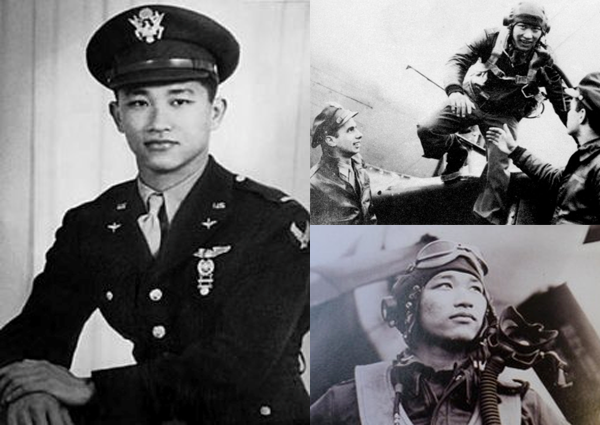Wau Kau Kong - Army Air Force
2nd Lieutenant Wah Kau Kong, born January 17, 1919 in Honolulu, Hawaii; was the first Chinese American fighter pilot. Kong became a chemist for the United States Government after graduating from the University of Hawaii. As a research chemist he could have avoided being called to combat duty. Instead, Kong chose to volunteer for the United States Army Air Forces after the Attack on Pearl Harbor. He recorded the highest national score in his entrance examination and was accepted into the aviation cadet training program. Kong graduated from flight school in May 1943, becoming the first Chinese American fighter pilot. On October 23,1943 Kong boarded a convoy for England. He was assigned to the 353rd Fighter Squadron of the 354th Fighter Group at RAF Boxted. He was assigned to flying a new and powerful aircraft, the P-51B Mustang, which he named "Chinaman's Chance" on one side and "No Tickee No Washee" on the other. On February 11, 1944, (his 12th mission) Kong claimed his first victory while returning from a bomber escort mission to Frankfurt. He claimed 1.5 victories before being killed in action on his 14th mission over Blomberg, Germany February 22, 1944. He was awarded the Air Medal for “meritorious achievement in combat” and is interned in the National Cemetery of the Pacific.
Richard Y. T. Char - Army
Richard Y.T. Char was born and raised in Honolulu, Hawaii. He attended Farrington High School up to the tenth grade. Then after the attack on Pearl Harbor on December 7, 1941, all the schools were closed for two months. In his own words, “I made a big mistake when I didn’t return to school when the schools reopened. I continued working…” But he did the next best thing and enrolled in vocational school in the machinist program and “worked for the Army Engineering Department as a machinist til I was drafted into the Army when I was 18 years old. The same day the war ended. I decided to volunteer for three years in the Signal Corps and serve my time in China…” Serving with the American occupation forces in China between January 1946 and February 1947, and witnessing firsthand the conflict between the Kuomintang - Nationalist Party of China (KMT-NPC) and the Communist Party of China (CPC) was an interesting and exciting time for him. It helped shape his love and interest in Chinese culture and history. After he was discharged from the Army, he returned to Hawaii where he married and started a family. He began a long 34-year career at Kodak Hawaii starting first as a maintenance worker and then working his way up and earning the title of Senior Engineer - all this in spite of his lack of a formal education. He eventually was promoted to Production Supervisor, “the number two man in the Honolulu lab…” After retirement, he and his wife Betty travelled extensively and especially enjoyed their trips back to China. He was an active member of many Chinese societies in Hawaii including the See Dai Doo Society. He passed away in 2013 and is buried at the National Cemetery of the Pacific.

